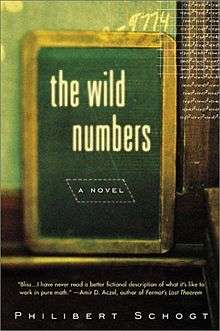The Wild Numbers
 Softcover edition | |
| Author | Philibert Schogt |
|---|---|
| Original title | De wilde getallen |
| Translator | Philibert Schogt |
| Country | The Netherlands |
| Language | Dutch |
| Subject | Novel |
| Genre | Mathematical fiction |
Publication date | 1998 |
Published in English | 2000 |
The Wild Numbers is a mathematical fiction in the form of a short novel by Philibert Schogt, a Dutch philosopher and mathematician. It was first published in Dutch (as "De wilde getallen") in 1998 and an English translation appeared in 2000.[1] Through this work the author is trying to provide insights to the workings of a mathematics-obsessed mind. It is the story of a professor of mathematics who believes he has solved one of the great problems of mathematics -- Beauregard's Wild Number Problem. In the imaginary settings of the novel, the problem is presented as a real mathematical problem seeking a solution and not as delusion of the protagonist. But in the real mathematical world, there is no such problem; it is a fictitious problem created by the author of the book.
The plot
The novel is presented as a naration by the protagonist, Isaac Swift, of the story. Isaac Swift is an able, though not brilliant, mathematics professor in a small college in an unnamed city in an unnamed country. When the novel opens Swift is in his mid-thirties and desperately trying to establish himself as a mathematician. A respected senior faculty of the mathematicss department of the college has just given his seal of approval to Isaac's paper describing a proof of the wild number problem. Isaac hoped that he would soon be famous and interviewed and feted. Immediately a crisis developed as Swift was accused of plagiarising a proof of the problem already discovered by an older student Leonard Vale. Vale's accusation was generally ignored because of his cranky behaviour in the department and his tendency to make tall claims on unsolved problems.
Reviews
- "The Wild Numbers by Philibert Schogt". Complete Review. Complete Review. Retrieved 25 March 2016.
- "The Wild Numbers". The Publishers' Weekly. Retrieved 25 March 2016.
- Fernando Q. Gouvêa. "The Wild Numbers". MAA Review. Mathematical Association of America. Retrieved 25 March 2016.
- Allyn Jackson (November 2000). "Book Review: Uncle Petros and Goldbach's Conjecture and The Wild Numbers" (PDF). Notices of AMS. 47 (10): 1274 – 1275. Retrieved 25 March 2016.
- David Foster Wallace (22 December 2000). "Rhetoric and the Math Melodrama". Science: 2263 – 2267. Retrieved 27 March 2016.
See also
References
- ↑ Alex Kasman. "The Wild Numbers". Mathematical Fiction. Alex Kasman. Retrieved 22 March 2016.